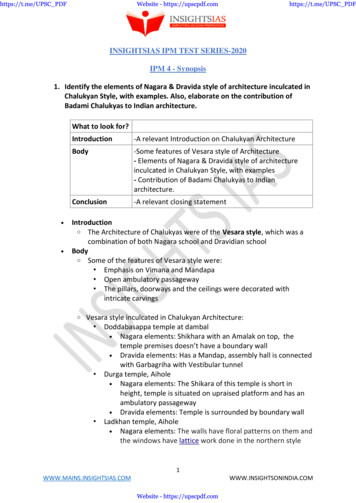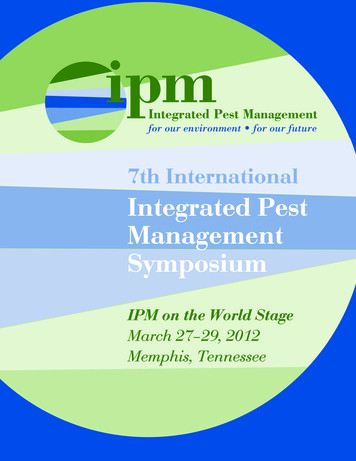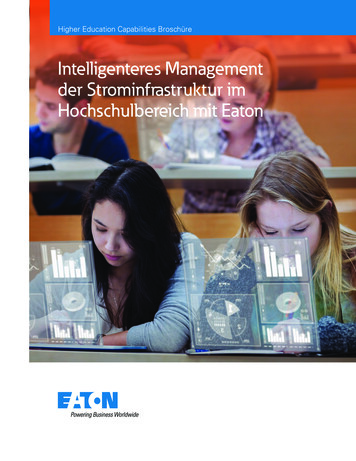
Transcription
https://t.me/UPSC PDFhttps://t.me/UPSC PDFWebsite - https://upscpdf.comINSIGHTSIAS IPM TEST SERIES-2020IPM 4 - Synopsis1. Identify the elements of Nagara & Dravida style of architecture inculcated inChalukyan Style, with examples. Also, elaborate on the contribution ofBadami Chalukyas to Indian architecture.What to look for? Introduction-A relevant Introduction on Chalukyan ArchitectureBody-Some features of Vesara style of Architecture- Elements of Nagara & Dravida style of architectureinculcated in Chalukyan Style, with examples- Contribution of Badami Chalukyas to Indianarchitecture.Conclusion-A relevant closing statementIntroductiono The Architecture of Chalukyas were of the Vesara style, which was acombination of both Nagara school and Dravidian schoolBodyo Some of the features of Vesara style were: Emphasis on Vimana and Mandapa Open ambulatory passageway The pillars, doorways and the ceilings were decorated withintricate carvingsoVesara style inculcated in Chalukyan Architecture: Doddabasappa temple at dambal Nagara elements: Shikhara with an Amalak on top, thetemple premises doesn’t have a boundary wall Dravida elements: Has a Mandap, assembly hall is connectedwith Garbagriha with Vestibular tunnel Durga temple, Aihole Nagara elements: The Shikara of this temple is short inheight, temple is situated on upraised platform and has anambulatory passageway Dravida elements: Temple is surrounded by boundary wall Ladkhan temple, Aihole Nagara elements: The walls have floral patterns on them andthe windows have lattice work done in the northern .COMWebsite - https://upscpdf.com
https://t.me/UPSC PDFhttps://t.me/UPSC PDFWebsite - https://upscpdf.com Dravida elements: Temple built in Panchayatana style, Theroof above the maha mandapa shows a turret as a firstversion of the futures towers shikharas and vimanasPattadkal temple It is a temple complex These reflect fusion from North India, with Rekhaprasad/Latina type Shikharas; and other temples havingVimana as in Dravidian style Six temlpes are built in the Dravida style, four in Nagarastyle, while the Papanatha temple is the fusion of the twoNagara ArchitectureDravida ONINDIA.COMWebsite - https://upscpdf.com
https://t.me/UPSC PDFWebsite - https://upscpdf.comhttps://t.me/UPSC PDFo Contribution of Badami Chalukyas to Indian architecture: Earliest temples date back to around 450AD Early Chalukyan style originated in Aihole and was perfected inBadami and Pattadkal Their blended Vesara style include two types of Monuments:Rock cut halls or '' Cave temples'' and ''Structural'' temples, builtabove ground The cave temples are basically excavations, carved out of theliving rock sites they occupy. These were not built as theirstructural counterparts, rather were created by a specialtechnique known as 'subtraction' and are basically sculptural Badami Cave temples These have rock cut halls with basic features, such as pillaredveranda, columned hall and sanctum cut out deep into rock It has three cave temple, one each in Vedic, Buddhist andJaina styles Important feature is the running frieze of Ganas in variousamusing postures caved in relief The most prominent carving in these is the cave number 1,which has carving of Tandav dancing Shiva as Nataraja Pattadkal Temple complex: Of the ten temples in Pattadakal, six are in Dravidian styleand four in Rekhanagara style The nine Hindu temples are all dedicated to Shiva, and areon the banks of Malaprabha river UNESCO has described Pattadakal as "a harmonious blend ofarchitectural forms from northern and southern India" andan illustration of "eclectic art" at its height. These temples feature elements of Vaishnavism andShaktism theology Ravanphadi temples This is a rock cut shrine and shivalaya It has rectangular frontage with square inner wall Interior has on its wall dancing shiva with ten hands This is assigned to the 6th centuryConclusiono Thus, in this way, various factors such as religion, customs,geographical location and patronage influenced the architecture NINDIA.COMWebsite - https://upscpdf.com
https://t.me/UPSC PDFhttps://t.me/UPSC PDFWebsite - https://upscpdf.com2. “India’s participation in the Liberation of East Pakistan is driven by anelement of self-interest apart from the humanitarian aspect.” In the contextof the above-mentioned statement, critically examine India’s role in thecreation of Bangladesh.What to look for? Introduction-When and why Liberation of Bangladesh?Body-Trace the events that led to the crisis situation-Directive is to ''Critically Analyse''-So pros and cons in the direction of rationaleasked in question is needed-Analyse India's role in liberation from bothHumanitarian and Self-Interest ViewsConclusion-Ending should have closure; can conclude either waysIntroductiono In 1971, a major political-military crisis broke out in East Pakistan, towhich India was inevitable drawnBodyo The lack of Political democracy, along with discrimination against EastPakistan developed a powerful movement, calling for greaterAutonomy for East Pakistano Instead of coming to terms with movement, ruling elite of Pakistandecided to supress it, which ultimately transformed it into a movementfor Independence from Pakistano Pakistan army resorted to virtual genocide, for which there was a waveof sympathy for the people of East Bengal and a strong demand foraction against Pakistano India's role in liberation - from 'Humanitarian' view: India gave sanctuary to the Bangladeshi Government in Exile India wanted to solve the refugee problem across porous borderswith Indian states and find a permanent solution to it War demonstrated the strength of Indian secularism: withHindus, Muslims, Sikhs all standing together for crisis against aMuslim countryoIndian Self Interests - causing liberation of Bangladesh: Indian army gave military training on Indian soil and military aid inmoney From outset of 1971, Indian armed forces began preparing forMilitary action, to finish operation quickly before big GHTSONINDIA.COMWebsite - https://upscpdf.com
https://t.me/UPSC PDFhttps://t.me/UPSC PDFWebsite - https://upscpdf.com India after victory, altered the balance of power in South Asia byemerging as a pre-eminent power Humiliating defeat with China in 1962, was wiped out and Indiarestored its lost pride and self-respect India asserted its independence in foreign affairs and in defenceof her national interest Defeat to Pakistan would mean a big blow to the two-nationtheoryConclusiono India by sticking to policy of restraint, with careful planning andeducated International opinion, conquered its self-interests with ashow of Diplomatic & Military prowess3. “Treaty of Versailles contained the seeds of World War II.” Examine thestatement in reference to the provisions of the treatyWhat to look for? Introduction-Relevant facts on Treaty of VersaillesBody-What were the terms of treaty ofVersailles?-Explain how the treaty made World war 2possibleConclusion-A relevant closing statementIntroductiono Word war 1 officially ended with the signing of the Treaty of Versaillesin 1919Bodyo The treaty was a move by the European countries, to deal with harshPunishment to Germany, for its role in World war-a move that wouldsoon come back to haunt the worldo Terms of the treaty: Document stripped Germany of 13% of its territory and one-tenthof its population The Rhineland was occupied and demilitarised, and Germancolonies were taken over by new league of Nations German army was diminished, weapons confiscated and navystripped of large vessels Treaty required Germany to pay 269 billion gold marks - theequivalent of 37 billion, in reparations to the allied IA.COMWebsite - https://upscpdf.com
https://t.me/UPSC PDFhttps://t.me/UPSC PDFWebsite - https://upscpdf.como Treaty of Versailles made World war II possible: Harsh measures inflicted on Germany, inspiring to rise again Germany's economic woes, exacerbated by the burden ofreparations and general European inflation, destabilised theWeimar republic Due to lasting resentment of the Versailles treaty, radicalright wing parties gained support in 1920s, by promising tooverturn harsh provisions and make Germany a majorEuropean power once again The National Socialist Party used widespread anger aboutVersailles, along with the economic collapse of the GreatDepression to come to power in 1933 New European borders and the league of Nations The treaty redrew the borders of Europe, which resulted inlarger number of smaller powers; this meant the balance ofpower was less stable Lack of coherent Vision, for united world peace, after 1919 In USA president Woodrow Wilson's view, all nations postworld war would reduce armed forces, preserve freedom ofseas and join International peace keeping organisation called'league of nations' But fellow Allied leaders rejected this, particularly Frenchwho wanted Germany to pay a heavy price for war Inability of treaty's terms to come in place, allowed forSoviet and Japanese expansionismConclusiono The treaty inevitably was a part of recipe, which caused World war 2,rather than preventing one4. Examine to what extent the women’s movement has been successful inaddressing the concern of deprivation and oppression in all forms.What to look for?Introduction-Women's movement in BriefBody-Women's movement in India, addressingtheir concerns-Concerns of Women still not addressedConclusion-A relevant way IA.COMWebsite - https://upscpdf.com
https://t.me/UPSC PDF Website - https://upscpdf.comhttps://t.me/UPSC PDFIntroductiono Women's movement, known as the Feminist movement are a series ofcampaigns to address women's issues, and generally seek equal rights andopportunities and greater personal freedom for womenBodyo The status of women has been the central concern of many reformmovements before and after Independenceo Women's movement in India, addressing their concerns: Women's Basic rights have been met, through their assertion fromthe following movements #Metoo movement Inspired by a global campaign against sexual harassmentand assault, women across the spectrum opened up andshared their stories about abuse by men in positions ofpower This resulted in penalising the people in power anddiscouraged misogynistic work spaces for women andencouraged more conducive, safe and healthy workingenvironments The family values are changing, with women becomingmore aware of feminist trends as opposed to the previousgenerations Women and child development ministry even proposed toset up 'a committee with senior judicial and legal persons’,as members to look into all issues emanating from the#MeToo campaign Women fighting for their Right to 'Temple Entry'. This wasevident at the Sabarimala temple, where the Supreme Courteventually made a decision in their favour. Greater Assertivenesswas seen in the way Women forced themselves into temples,amidst all opposition, after court’s verdict The reporting of 'Gender based crimes', such as Sexual assault,Domestic Violence, cases of rape, has risen significantly, which weremotivated through the following movement Gulabi Gang The group fought against gendered social evils, in 2002 Wearing pink sarees and carrying bamboo sticks, theyfrequently resorted to violence in order to make theirvoices heard Even though this movement didn't result in significantchanges for women, it sensitised gender oppression issuesand set a moral restraint on societal .COMWebsite - https://upscpdf.com
https://t.me/UPSC PDFWebsite - https://upscpdf.comhttps://t.me/UPSC PDF Delhi Gang Rape case: Landmark feminist movement in India In 2012, the streets surrounding Rashtrapati Bhawan inNew Delhi was teeming with thousands of people out inanger against the brutal rape of a 23-year-old girl The echo spread throughout the country soon, and largenumber of women came out to protest vehemently againstthe inability of the government to provide adequatesecurity to women The incident and the movement resulted in significantchanges for betterment of women security in India, suchas: India’s rape law (Section 375/376 of IPC) expandedthe definition of rape beyond peno-vaginalintercourse, and now Voyeurism, stalking and acidattacks are now punishable crimes The Criminal Law Amendment Act 2013 makes iteasier for survivors to seek medical help and justice;As a result of which, More women now bravely reportviolence There is even a campaign for compulsory gendersensitisation programmes in all of India’s schoolsWomen have taken measures to assert their 'Right to life', by fightingsocial evils, evident in movements like Anti-liquor movement in Andhra Pradesh In the early 1990s, women in rural Andhra Pradesh took itupon themselves to fight against liquor dependency amongtheir men and the subsequent verbal, physical andemotional abuse that followed They had just one simple demand: “no drinking or sellingliquor” The women took to range of actions, such as rushing toliquor stores to destroy packets and decided to reform menon home front The women led struggle ultimately led to a state wide banon liquor in 1995.Their concerns of empowerment have been addressed by the law, asit provides for women's reservation at local government levels The demand for Reservation in Parliament and State Assembly,indicates the growing concerns to address their DIA.COMWebsite - https://upscpdf.com
https://t.me/UPSC PDFhttps://t.me/UPSC PDFWebsite - https://upscpdf.com The various Schemes to uplift women, have also empowered them tofight against the oppressions, a few which are as follows: Swadar Greh - To prevent women from exploitation and supporttheir survival and rehabilitation Stand Up India - To support Entrepreneurship among Womenand SC/ST communitieso Women's concerns, Not really addressed, as: The practice of 'Husbands of women Sarpanches' or 'Sarpanch Pati' stillexercise undue influence on the work of their wives elected to power Even though Women comprise 42% of the agricultural labour force inthe country, signifying increasing feminisation of agriculture, yetwomen own less than 2% of farm land Female Infanticide is still an issue in India because: Of preference of son over daughter Dowry system, which makes daughters ''an unaffordableeconomic burden'' Environmental vagaries, still force Women in Rajasthan to fetch waterin multiple trips, form faraway placesConclusiono Women's movements have met with justice, which is evident in form oflegislative actions. But, implementation in true spirit is lacking, because ofsocietal Inertia, which are evident in form of unaddressed concerns5. Explain the reasons behind the rise of crime against women. Discuss,especially in context of the new forms of gender violence that are takingplace.What to look for? Introduction-A fact/statement to establish relevance to rising crimesagainst womenBody-Reasons behind rise of crime against women-Measures taken to address such crimes in briefConclusion-A relevant closing statementIntroductiono The ''Unnao Case'' highlights disturbing details on the extent oflawlessness and arm-twisting of administrative machinery, leading toincreased crime against .COMWebsite - https://upscpdf.com
https://t.me/UPSC PDF Website - https://upscpdf.comhttps://t.me/UPSC PDFBodyo The National Family Health Survey(NFHS-4), revealed that every thirdwoman in India has faced domestic Violence of some form since theage of 15o The new forms of Gender Violence are taking shape in form of Acidattacks, Gang Rapes, Dowry deaths, Marital Rapeo Reasons behind rise of crime against women: The high rates of incidence of rape, are because of patriarchy andskewed sex ratio Entrenched Patriarchy in Indian families vests the power basedon age and Gender, in Indian Families, which Hinders Womenempowerment India is a deeply patriarchal society where women, particularlyyoung girls are kept under tight control, discouraging them fromopening up about sexual abuse at home or at work. This attitudeis mainly because of fearing repercussions An unresponsive law and order mechanism, inhibits women fromfiling complaints at work or with the Police. Even for a seriouscrime such as rape, a police officer will often advise the victim towithdraw her complaint and instead strike a ''compromise'' The shambolic criminal justice system remains vulnerable topolitical pressures and allows the powerful to go scot free;Women issues have also failed to turn up in Political agendaeffectively Cruelty by husband or his relatives have led to dowry deaths,abetment of suicide of women, causing miscarriage withoutwomen’s consent, human trafficking Alcohol abuse have caused Spousal violence in the form ofsexual, Physical and Emotional assault Workplace are still not completely safe, as Power and control areleading to sexual Harassment at workplace; This was evident inthe ‘#metoo campaign’, where dozens of high-profile men wereaccused of sexual misconduct Increasing assault on women with the intent to outrage hermodesty, lead to stalking ,Voyeurism, Verbal harassment andGroping of women Unsafe abortions, Marital rape, dowry deaths are still prevalentbecause of the presence of outdated laws and ignorance of paceof changing times, which have all added to woes of women insidehouseholds With increased digital proliferation and social media connectivity,cybercrimes against women are also on the .COMWebsite - https://upscpdf.com
https://t.me/UPSC PDFhttps://t.me/UPSC PDFWebsite - https://upscpdf.como Measures taken to prevent crimes against women: Legislative framework provides protection with Sexualharassment act 2013, Dowry Prohibition act in place Other interventions include One stop centres-SAKHI, womenhelpline, Nirbhaya Fund, Mahila shakti kendras, etc Recently, a scheme to prevent Cyber crimes has been launchedwith a reporting platform, forensic laboratory, cybercrimeawareness activities in place ‘Beti Bachao Beti Padhao scheme’ has been launched to addressissues of skewed sex ratio UJJAWALA scheme is for the Prevention of trafficking and Rescue,Rehabilitation and Re-Integration of Victims of Trafficking andCommercial Sexual Exploitation Schemes such as ‘Stand Up India’, Mahila E-haat, Mahila ShaktiKendras empower women economically and strive to break theentrenched stereotypesConclusiono A woman’s clock is less about the time of day and night, and moreabout the times that are “safe" and “unsafe. With rising crimes, safetyhas become an instrumental element to attain true freedom forwomen in India and hence the need for Change in Social Attitudes6. “Globalisation is generally said to have significant impact on youngergeneration in economic, social and cultural terms”. Elucidate.What to look for? Introduction-What is Globalisation?Body-Impact of Globalisation on younger generationConclusion-A relevant way forward on GlobalisationIntroductiono Globalisation refers to the integration of markets in the globaleconomy, leading to increased interconnectedness of nationaleconomiesBodyo Globalisation affects young people disproportionately, given theirtenuous transitional status within an uncertain and rapidly evolvingglobal DIA.COMWebsite - https://upscpdf.com
https://t.me/UPSC PDFWebsite - https://upscpdf.comohttps://t.me/UPSC PDFImpact of Globalisation on Younger generation:Cultural Aspects Consumerism and young people today – the change that hastaken place in society that marks a person more by what theywear and what they have, rather than by who they are Intermixing of cultures and liberal ideals has resulted in negativeconsequences on children, with increasing parental divorce The merger of Culture have resulted in a Global Monoculture,evident in form of McDonalds, Netflix etc. New ways of thinking have emerged among youth which aims forquicker, easier and more effective ways, over previous traditionalways With advent of technology and ease of access to it, youth culturehas turned to virtual communications, and lesser familycommunications on a group basis Economic aspectsGlobalisation has increased access to education, in urban areasmainly with coming of privatisationThe dominant Service sector and Outsourcing ease met byGlobalisation, has resulted in creation of jobs and higher incomesfor younger generationsIts subsequent effects of sharp increase in income, have resultedin Rural-Urban divide, which the Government is trying to closethe gapOn the other hand, for many Government, the ability to providebasic education is being greatly diminished by the demands ofservicing foreign debts overseen by IMF and World BankYoung people at the sharp end of Globalisation have found thatwhile opportunities may well increase, more often, however,inequitable relationship institutionalise poverty by concentratingresources and wealth amongst economically dominant sectionsSocial AspectsIncreased connection and inter mingling of cultures offers achance to reduce influence of Racism and Xenophobia amongthe youthFaster and lower cost transport, as well as the development ofinformation and communications technology (ICT) has improvedhuman mobility, particularly among youthsIncreased connectedness has caused increased youth migrationin search of better educational, economic and social INDIA.COMWebsite - https://upscpdf.com
https://t.me/UPSC PDFWebsite - https://upscpdf.comhttps://t.me/UPSC PDF The Family structure has transitioned from big Joint family toNuclear small ones now Rigidity of Castes and Customs have been reduced; More liberalforms such as the ‘Live-in-relationships’ are evident now The Class distinctions have emerged in urban location because ofwealth, knowledge and power, than the earlier distinctions basedcaste, hierarchy and Birth Primitive tribes have also been engulfed by Globalisation process,as many tribes in the regions of India have lost their identity,social life and have borne the brunt of exploitation &displacementConclusiono Globalisation has turned out to be more beneficial for developednations, than the developing ones. Hence, the need of collective effortto reap benefits of it7. Unless we sight migrant workers as a dynamic part of a changing India, theproblems concerning Urbanization will remain unaddressed. Comment.What to look for? Introduction-Why do Workers Migrate?Body-Seeing Migrant workers as Dynamic part of changingIndia-How such changed sight can solve unaddressedproblems concerning Urbanisation?Conclusion-A relevant way forwardIntroductiono Workers migrate in search of better job opportunities, livingconditions, peace and stability and security of life, and their movementis an integral factor in redistributing the population over time andspaceBodyo The 2011 Census, says that 45 million Indians moved outside theirdistrict of birth, for work opportunitieso Many cities welcoming migrants show that Well managed migrationcan be an asset for economies and societies, particularly in the NDIA.COMWebsite - https://upscpdf.com
https://t.me/UPSC PDFWebsite - https://upscpdf.comoohttps://t.me/UPSC PDFWhy should we 'See Migrant Workers as a Dynamic part of changingIndia'? Countries such as China and Vietnam are embracing Migrantworkers for a competitive world economy, which India should beinspired from United Arab Emirates' development is largely built on Migrantworkforce Case Study: Kerala Embracing Migrant Workers By any Yardstick of Human and Social development, Kerala isahead of most Indian states Healthcare and education are good, and the workers arepaid well so as to sustain a long term proposition, yetkeeping the cost of living low All these factors have made Kerala, India's most attractivedestination for migrating rural poor Inter-state Media study show that the migrants have beenaccepted as inevitable part of Kerala Society Kerala Government too, has realised the importance, andhence has given effect to Migrant Inclusive Polices such ashealth Insurance schemes, housing schemes for migrantworkers All these measures, have resulted in lesser experience ofharassment and exploitation of Migrants The above prospects have resulted in no religious andcommunal polarisation in Kerala; and women and childrenare not in danger of predatory sexual violence of the kindthey are exposed to everyday in northern India. Also, Kerala's economy is now critically dependent onmigration - internal as well as externalWhich all problems of Urbanisation can be addressed, by seeingMigrants under such Dynamism? Providing affordable housing to migrants along with basicfacilities such as sanitation, drinking water, would preventformation of slums; Proper housing planning would alsodistribute the population evenly, which is a common problem inUrban areas Extending a sense of inclusiveness to Migrants, could preventcommunal polarisation and sexual violence Loss of identity and Government not identifying migrants, makesit difficult for the migrants to avail basic services, which in longrun will result in Poverty & Inequality, and eventually result inincreased crime, drug abuse and SONINDIA.COMWebsite - https://upscpdf.com
https://t.me/UPSC PDFhttps://t.me/UPSC PDFWebsite - https://upscpdf.com Government identifying workers from other states, will solve theissues of identity loss of migrant workers, lack of access toentitlements/social services such as subsidised fuel, food, healthservices or education Linking Migrant policies to employment and social services, willaddress range of problems related to Financial access, healthcare,Social Exclusion, Political exclusion Making Educational facilities accessible to Migrant Children,would go in direction to prevent Child labour Providing them better living conditions to assimilate them intosociety, would bring in a sense of shared culture among thenatives, which can go till the way to prevent Mob attacks Environment issues that add to Pollution woes, by burning woodfor cooking, plastic pollution could all be addressed by providingadequate resources to Migrants Treating migrant workers on equal lines, would settle Conflictsand disputes at worksites related to non-payment of wages,physical abuse, accidents at workplace, and eventually reducedexploitationConclusiono Thus, it is imperative to integrate, educate, empower and enable highstandards of living in all regions, for the Migrants to witness betterdevelopment of India8. The formation of Indo-Gangetic plain is closely related to the formation ofHimalayas. In this context, Bring out the Geomorphological features of Indo– Gangetic – Brahmaputra PlainWhat to look for? Introduction-What is meant by a plain?Body-Geomorphological features of Indo – Gangetic –Brahmaputra PlainConclusion-A relevant closing statementIntroductiono Indo-Gangetic-Brahmaputra plains are a gradational plains and formone of the youngest landform in IndiaBodyo Geomorphological features of the IA.COMWebsite - https://upscpdf.com
https://t.me/UPSC PDFWebsite - https://upscpdf.com https://t.me/UPSC PDFBhabarIt is a narrow belt about 8-16 km wide, running along East-Westdirection along the foot of ShiwaliksRivers descending from Himalayas deposit their load alongfoothills in form of alluvial fansThese fans, consisting of gravel and unsorted sediments, merge toform Bhabar belt, which forms the northern boundary of GreatPlainThe porosity of rocks is so high that, most streams sink and flowundergroundArea is not suitable for agricultureTeraiIt is a 15-30km wide tract, south of BhabarIt is marked by re-emergence of the underground streams onBhabar beltThe re-emerged water converts large areas along rivers into, illdrained marshy lands of excessive dampness covered with thickforestsMost of this land is good for agriculture, and gives good crops ofSugarcane, rice and wheatBhangarIt is region composed of old alluvium and forms alluvial terraceabove level of flood plainsIt is often impregnated with calcareous concretions known asKankarIt also contains fossils of animalsKhadarIt is composed of newer Alluvium and forms flood plains alongthe river BanksThese deposits are confined to vicinity of river channelsKhadar merges into the deltaic regionsReh/KallarComprises barren saline efflorescence of drier areas in UttarPradesh and DIA.COMWebsite - https://upscpdf.com
https://t.me/UPSC PDF https://t.me/UPSC PDFWebsite - https://upscpdf.comConclusiono Thus, Himalayas with their slope of flow and material deposits, hasshaped the Geomorphological features of Indo – Gangetic –Brahmaputra Plain9. Examine the distribution of jute industries in India. What are the problemsfaced by jute industries? Suggest remedies to overcome them.What to look for? Introduction-A relevant Introduction on Jute/Jute IndustriesBody-Distribution of Jute Industries in India-Problems of Indian Jute Industry-Potential Measures, for betterment of Jute IndustryConclusion-A relevant way forward on Jute IndustriesIntroductiono Jute, the Golden Fibre, being natural, biodegradable and Eco-friendly,has great Utility as raw material and as finished productBodyo Distribution of Jute Industries in India: Since Jute Industry, is mainly a raw material
evident at the Sabarimala temple, where the Supreme Court eventually made a decision in their favour. Greater Assertiveness was seen in the way Women forced themselves into temples, amidst all opposition, after court [s verdict The reporting of 'Gender based crimes', such as Sexual assault,










